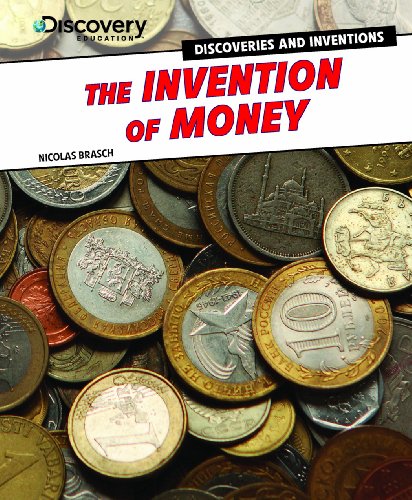-
George Eastman and the Kodak Camera
Jennifer Lee Fandel, Al Milgrom, Gordon Purcell
Library Binding (Capstone Press, Jan. 1, 2007)Tells the story of George Eastman and the invention of the Kodak camera. Written in graphic-novel format. R
R
-
Eli Whitney and the Cotton Gin
Jessica Gunderson, Charles Barnett III, Rodney Ramos, Gerry Acerno
Library Binding (Capstone Press, Jan. 1, 2007)Tells the story of how Eli Whitney invented the cotton gin, and the effects it had on the Southern United States. Written in graphic-novel format. S
S
-
Alexander Graham Bell and the Telephone
Jennifer Lee Fandel, Keith Tucker
Library Binding (Capstone Press, Sept. 1, 2006)Tells the story of how Alexander Graham Bell came up with the telephone, and how his invention changed the way people communicate. Written in graphic-novel format. R
R
-
The Industrial Revolution: Age of Invention
Nicolas Brasch
Paperback (PowerKids Press, July 15, 2013)During the 1800's, electrical lights, inter-continental transportation, medical advancements, and distribution of labor dramatically altered the ways that people could work, travel, eat, and communicate. This book captures the spirit of discovery that characterized the tumultuous century, while exploring the lasting legacy of these discoveries, and their impact on human life. Illustrated timelines, primary source photographs, and clear diagrams explain the inventions of the era, while informative sidebars add depth. An informative and engaging book about a complicated era of history. R
R
-
Creating and Cracking Codes
Lesley McFadzean
Paperback (PowerKids Press, July 15, 2013)Records show that human beings have been using codes to conceal messages for over 2,000 years! This revealing book traces codes throughout history, from an encryption device used by the Spartans in 400 B.C. to the Enigma Code of the 1940s, pausing to consider coded military secrets and newspaper scoops alike. Students will be delighted by code-cracking diagrams. Illuminating sidebars, primary source documents, and vivid illustrations all add to this attractive volumes appeal. S
S
-
The Wright Brothers and the Airplane
Xavier W. Niz, Charles Barnett III, Keith Williams, Steve Erwin
Library Binding (Capstone Press, Jan. 1, 2007)Tells the story of how Wilbur and Orville Wright developed, tested, and successfully flew the first powered airplane. Written in graphic-novel format. S
S
-
The Invention of Money
Nicolas Brasch
Paperback (PowerKids Press, July 15, 2013)People in Asia Minor developed the first coin-based currency, but long before that humans would exchange precious objects for the things necessary for their daily life. Currency is a fact of human life, and this book explores its genesis, beginning with those early coins and precious objects and tracing their legacy to the banknotes and fraud-detecting devices of the twenty-first century. Photographs and illustrations explore the remarkable diversity and detail of contemporary currency, while engaging text explores moneys utility and places it within a social context. N
N
-
Marie Curie and Radioactivity
Connie Rose Miller, Mark Heike, Scott Larson
Library Binding (Capstone Press, Sept. 1, 2006)Tells the story of Marie Curie's discovery of radium and radioactivity. Written in graphic-novel format. T
T
-
Machines in the Office
Rodney Dale, Rebecca Weaver
Paperback (Oxford University Press, March 17, 1994)Here's a wide-ranging survey of mechanical and technological history that offers more than dates and facts. The evolution ofinvention takes center stage here. The authors believe that how society came to need or want new gadgets and machines is a major part of the history of technology and discovery. For example, Home Entertainment looks at inventions in the early part of the century that were developed to enliven leisure time. But author Rodney Dale and Rebecca Weaver trace the parallel social history as well and discover that: *domestic appliances were reducing the time needed for daily chores *the rise of the suburb renewed the national emphasis on family spirit and happiness *a larger middle class had a bit more money to spend on non-essentials *the growing sciences of psychology and psychiatry were beginning to suggest that enjoyable leisure time was actually healthy and should be encouraged (a far cry from our Puritan beginnings) The phonograph may have been invented to keep us amused after office hours, but it was our growing need to find "self-fulfillment" in play as well as work that made its invention necessary. Each book is a superbly illustrated survey of one aspect of modern life and how it has grown in response to the social changes of the times. Patents, models, photos, advertisements, cartoons, and sketches from contemporary sources provide interesting and entertaining illustrations from the swift and often humorous text. From the quill pen to the computer, from the Magic Lantern to television--these books look at why as well as how we've come such a very long way. O
O
-
Dinosaur Hunters
Robert Coupe
Library Binding (PowerKids Press, July 15, 2013)It has been nearly 200 years since the first dinosaur remains were found in southern England, and in that time these fascinating creatures from long ago have lost none of their hold on our imagination. This book explores the history of dinosaurs and their time on earth. A detailed timeline traces the archaeological discoveries that inform todays study of prehistoric life, and clear, informative illustrations and diagrams explore different kinds of dinosaurs, their appearance and scale, habitats and intellect, and the fossils they left behind. T
T
-
That Improved Our Daily Lives
Antonio Casanellas
Library Binding (Gareth Stevens Pub, Jan. 1, 2000)Explains the operation of common devices such as the doorbell, alarm clock, photocopier, radio, television, and computer; includes instructions for science experiments relating to these. O
O
-
George Eastman and the Camera
Monica L. Rausch
Paperback (Weekly Reader/Gareth Stevens Pub, Jan. 12, 2007)Describes the impact of the Eastman dry film camera and its development process on photography, especially for amateurs, and recounts the life and career of their inventor, George Eastman. L
L